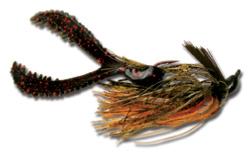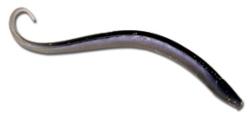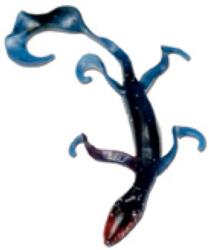Get bit
New FLW Outdoors lures hit shelves this January!

Last year, the pro staff of Mann’s Bait Company was challenged to develop five essential bass baits that would be superior in each lure’s class. Key players in this brain trust included Dan Morehead, the Wal-Mart FLW Tour’s 2003 Land O’Lakes Angler of the Year, and Bassmasters Classic champions Mike Iaconelli, Hank Parker and Paul Elias.
The initial meeting of the minds at Mann’s headquarters in Eufaula, Ala., was a pressure cooker. Each of these accomplished anglers had strong opinions regarding which baits should be in the lineup and which features should be incorporated into each bait. When the smoke finally cleared, the lure designs were on paper, and the anglers, somehow, remained friends.
The five baits included a tube, worm, lizard, jig and a jig trailer. These lures would eventually be FLW-brand baits available only at Wal-Mart stores.
“This was conceptual in the beginning, but over several months, we’d get prototype baits, test them, and send them back with specific suggestions for improvements,” Iaconelli said. “The baits went back and forth three or four times.”
Testing took place at bass ponds near the Mann’s factory and on bass waters across the country. Fishermen may have good ideas about what bass want, but only bass can confirm these theories.
“We didn’t do anything fancy or gimmicky,” Parker said. “We didn’t create baits that are not already on the market in some form or another. We just made the premier bass baits the best they can be made.”
FLW Jig
Priority No. 1 for a bass jig is that it must come through thick cover without snagging. It must also penetrate a bass’s mouth easily on the hookset. These dynamics are at odds with each other, and many jigs don’t deliver on both ends. Only a superior jig excels at busting cover and hooking bass.
“All jigs look the same, especially to the average angler,” Parker said. “It’s hard to look at a jig and determine if it will be good in cover and for hooking bass. The size and style of the hook, the head design and the position of the line eye are critical. The FLW Jig got it right.”
Available in 3/8-, 1/2-, and 3/4-ounce sizes, the FLW Jig is built around a red, super-sharp, cross-eye, wide-gap hook. The cross-eye is at a 90-degree angle to the hook’s shank, so it slides over limbs and branches easier than a regular in-line eye. The wide-gap hook grabs bass fast, and the red color provides additional fish appeal.
 The hook guard comes trimmed. It extends slightly above the hook’s point and is cut at the perfect angle to improve the hook’s bite and give the bait a compact appearance. The pros usually make this modification themselves.
The hook guard comes trimmed. It extends slightly above the hook’s point and is cut at the perfect angle to improve the hook’s bite and give the bait a compact appearance. The pros usually make this modification themselves.
A barb under the skirt holds plastic trailers in place, and the jig’s chip-proof finish comes in colors that match the skirts. Jig colors include green pumpkin, black/blue, brown/orange, and pearl.
“The silicone skirts on this jig are thicker than on most jigs,” said Mike McPherson, director of operations for Mann’s. “Packaged with each jig will be a new FLW Jig Trailer in a matching color.”
FLW Jig Trailer
“I have to trim most of the jig trailers I use to reduce bulk and get a good tail action,” Parker said. “I don’t have to trim the 3-inch FLW Jig Trailer. It comes molded to deliver optimum action without all the bulk.”
Iaconelli is especially high on the FLW Jig Trailer’s action. He claims that most chunks – plastic and pork – have what he calls “neutral action.” They produce in cold water for sluggish bass but lack the pizzazz needed to catch active bass.
“I often try to trigger reaction strikes with a jig,” Iaconelli said. “I want a trailer that has a lot of action. The unique cut of the FLW Jig Trailer makes its thin legs kick back and forth. It’s a great trailer for swim-jigging. It also has a nice ribbed texture that gives it a crawfish look.”
The FLW Jig Trailer comes in four colors: pumpkinseed orange, watermelon violet, green gourd with red flake, and mulberry. The latter color combines dark red, bright blue and black.
“I’m really excited about watermelon violet,” Iaconelli said. “It’s more of a baitfish color and is ideal when you want to swim a jig.”
 FLW Tube
FLW Tube
The 4-inch FLW Tube has everything discriminating fishermen look for in a flipping/pitching bait – a bulky body, hot colors, tentacles that flare and a solid head.
“The thing I pushed for was a solid head,” Morehead said. “You have to have some extra plastic up front to anchor a big hook.”
Iaconelli was adamant about how the tentacles should perform. He stressed that they should pulse and breathe on every cast, not stick together.
“We got the tentacles to do what the pros wanted through an injection-molding process,” McPherson said. “Injection molding allows us to cut the tentacles in any shape and at an angle that makes them open up in the water.”
The tentacles on the FLW Tube are thicker in diameter than those found on other tubes. They hold up well and give the tube a better glide and a seductive, circular action on the fall. Because the tentacles are stiff and relatively short – 1 3/8-inches – they don’t latch onto limbs and other cover. This can be a headache when you’re trying to drop a tube into teacup-sized openings.
“Another thing I like about the FLW Tube is the texture,” Iaconelli said. “It has ribs and eyes. I think that’s important, especially in clearwater situations where you want the bait to look natural.”
Three essential colors make the FLW Tube effective in any water condition. They include green pumpkin, black/red flake and watermelon seed/candy.
 FLW Finesse Worm
FLW Finesse Worm
Because the Mann’s pro staff had to consider a wide variety of proven worms, they struggled to come up with a single design that would have the broadest appeal to bass in the greatest number of fishing applications. They settled on a 6-inch finesse worm that features a very thin, lively tail. It is enhanced with a subtle riblike texture, a smooth head and small eyes.
“If you were forced to fish with one worm, this is the one you’d want,” Iaconelli said. “The thin, finesse shape catches numbers of fish, even in cold-front conditions. It’s big enough to flip yet small enough for finesse fishing. If you bite an inch or two off the head, it’s the perfect bait for drop-shotting or split-shotting. You can’t beat it for versatility.”
The FLW Finesse Worm comes in red-shad swirl, green pumpkin, watermelon violet and June bug/red flake. Red shad, June bug and green pumpkin are three of the most universally productive worm colors ever created. The watermelon-violet hue is an excellent baitfish imitator. Iaconelli dotes on the swirl colors because each worm shows bass a unique pattern.
“We make the swirl patterns by alternately firing different colors into an injection mold,” McPherson said. “In this case, we shoot one color for half a second, close that nozzle, shoot the other color, and alternate back and forth and back and forth. It gives you the kind of color that you normally see only in expensive, hand-poured baits.”
 FLW Lizard
FLW Lizard
Mann’s entire pro staff agreed that the 6-inch lizard had to be included in the FLW line of baits. One feature Iaconelli wanted is what he calls “glideability.”
“I regularly fish a lizard on a Carolina or Mojo rig where the bait swims behind the weight,” Iaconelli said. “I don’t like a nose-heavy lizard that dives to the bottom. A lizard is much more effective if it glides after you pull it. We accomplished that by flattening the belly of the lizard just a little.”
Another key point with the pros was leg action. All four legs had to kick on every cast. The pros demanded it, and McPherson delivered.
“To get the leg action, we angled the legs down slightly and made them substantially thinner,” McPherson said. “It’s hard to mold thin legs, because you have to inject the plastic into extremely tight places. But that’s what the pros wanted, so we came up with a way to do it.”
The FLW Lizard comes in four colors: green pumpkin, cherry seed, smoke green violet and mulberry.
These five FLW baits are only the beginning. More lures will be added to the lineup using the same involved process that includes input and testing from accomplished tournament anglers.
“You can’t buy a better lizard, you can’t buy a better tube, you can’t buy a better worm, and you can’t buy a better jig or jig trailer,” Parker said. “When a person buys an FLW lure, they’ve got the best bass bait they can possibly buy.”